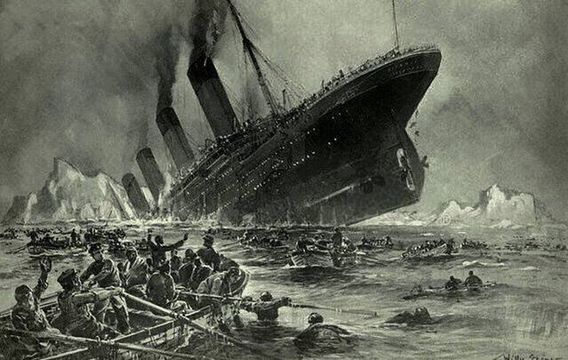
Untergang der Titanic by Willy Stower WikiCommons
The Titanic sunk on this day in 1912. Photos of the iceberg that the Titanic allegedly struck were released in 2012 to mark the centenary of the disaster.
Editor's note: In the early hours of April 15, 1912, the RMS Titanic sunk having struck an iceberg while en route to New York. Those icy waters claimed the lives of 1,517 people. The White Star Liner, built in Belfast, stopped off at Queenstown (present-day Cobh) on April 11 and then continued on its journey to New York. The "unsinkable" ship struck the iceberg on April 14.
On April 14, 1912, the Titanic tragically struck an iceberg in the cold Atlantic Ocean despite receiving seven warnings throughout the day of the imminent danger.
Read more: One of the Titanic's last mysteries solved
The collision
Britannica reports on the tragic turn of events that led to the disastrous collision: "Throughout much of the voyage, the wireless radio operators on the Titanic, Jack Phillips and Harold Bride, had been receiving iceberg warnings, most of which were passed along to the bridge. The two men worked for the Marconi Company, and much of their job was relaying passengers’ messages."
"On the evening of April 14, the Titanic began to approach an area known to have icebergs. Smith slightly altered the ship’s course to head farther south. However, he maintained the ship’s speed of some 22 knots."
"At approximately 9:40 PM the Mesaba sent a warning of an ice field. The message was never relayed to the Titanic’s bridge."
"At 10:55 PM the nearby Leyland liner Californian sent word that it had stopped after becoming surrounded by ice. Phillips, who was handling passenger messages, scolded the Californian for interrupting him."
Read more: The last letter written on board the doomed Titanic
How did the lookouts miss the iceberg?
"Two lookouts, Frederick Fleet and Reginald Lee, were stationed in the crow’s nest of the Titanic. Their task was made difficult by the fact that the ocean was unusually calm that night: because there would be little water breaking at its base, an iceberg would be more difficult to spot. In addition, the crow’s nest’s binoculars were missing."
"At approximately 11:40 PM, about 400 nautical miles (740 km) south of Newfoundland, Canada, an iceberg was sighted, and the bridge was notified. First Officer William Murdoch ordered both the ship “hard-a-starboard”—a maneuver that under the order system then in place would turn the ship to port (left)—and the engines reversed. The Titanic began to turn, but it was too close to avoid a collision."

Photo: Wikimedia Commons
Read more: 7 Reasons you should visit Belfast
Photos of the iceberg
Photos of the iceberg that may have sunk the Titanic became available as the world commemorated the 100th anniversary of the liner’s sinking in 2012.
One of the most striking images of the disaster, the picture has been preserved by Topham Picturepoint/Press Association Images and shows the iceberg, which the Titanic plowed into at 11:40 pm on April 14, 1912.
The iceberg lay at latitude 41-46N, longitude 50-14W, off the coast of Newfoundland. Newspaper reports of the time said that the visible part of the iceberg – that above the waterline – was anywhere between 50 to 100 feet high and 200 to 400 feet long.
The chief steward on board the Prinze Adelbert liner took the photo of the iceberg on the morning of the Titanic sinking.
Reports say he spotted a line of red paint along the bottom of the iceberg which experts believe show where it had made contact with Titanic.
TheJournal.ie reported that the steward was not aware at the time that it had been the iceberg that sunk the Titanic but the location, the marks on the iceberg and Titanic survivors’ descriptions of the iceberg triangulated to confirm that it was.
Read more: Game of Thrones real life UK Inspirations





Comments